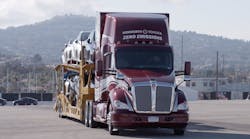The future of trucking is facing growing demands for near zero and ultimately zero-emission solutions. And, if the future of transportation is to be truly zero emission, then the long-term market victor will be electric. This includes pure battery electric, catenary electric and hydrogen fuel cell where well-to-wheel energy originated from non-emitting sources including wind, solar and hydro.
While it might take some time to get there, zero emission is where we are headed based on growing regulatory forces at work in the marketplace. Regional emission requirements may force zero-emission vehicle requirements in urban centers or possibly over entire regional routes. At the same time, these technologies are proving to deliver total cost of ownership with parity to today’s diesel.
Agencies at city, county, state, region and national levels are providing funding mechanisms to encourage purchasing zero and near zero emission vehicles. These programs are more often located in specific areas like California, Colorado, Texas, Massachusetts, Pennsylvania and New York, but there are programs all over North America. Funding appears available to nearly all alternative fuel types, but battery electric vehicles dominate.
It is important to remember that “near zero” or “partial zero” or “super low” emission still is not zero emission. Many of the alternative fuels cannot be considered zero emission, only pure battery electric and fuel cells are zero emission capable well to wheel when combined with solar and wind power generation.
People often use these terms interchangeably, but they are different. Near zero and partial zero are pretty vague terms. Near represents a very relative evaluation. When talking about percent reductions in emissions you need to start from a baseline. For example, a 50% improvement in fuel efficiency for a baseline of 6 mpg means an improvement of 3 mpg. That same 50% improvement for a baseline of 10 mpg would be an improvement of 5 mpg. The baseline matters when stating percentages.
But things are different when you talk zero emission. You don’t need a baseline to make a comparison. Zero is zero. The Department of Energy defines a zero emission vehicle this way: “a vehicle that produces no criteria pollutant, toxic air contaminant, or greenhouse gas emissions when stationary or operating.” It does not need to be compared to a baseline because zero is zero.
However, that zero emission future is not going to happen overnight. The bridge to the all-electric future may be long requiring a range of ever-improving technologies including renewable diesel and natural gas, a variety of combustion-based electric hybrids and fuel cells, catenary and battery electrics powered in part or in total by carbon and particulate emitting power stations.
These bridge technologies will have provided timely needed trucks for hauling freight but ultimately will become less desirable in the long run or relegated to specific duty cycles.
However, in the long-term, we see electric powertrains predominating in a zero-emission future. In the meantime, hard decisions will need to be made where zero and near zero emission zones eliminate the option of pure diesel vehicles. In that scenario, alternative fuel technologies will be weighed on their own merits and against each other’s rather than against diesel’s. Check out our report, Viable Class 7/8 Electric, Hybrid and Alternative Fuel Tractors for all the details of our thoughts.




